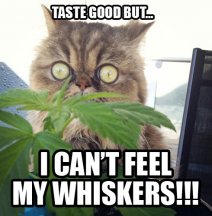Vee
Ancient Member
Every now and then you leave the door ajar to find a cat chewing on the remains of your finest (it actually happens)
....so what happens to the cat ...yeah a lab, they doped out some cats to find out, percentages are mind boggling ....lol
Objectives
The aim of this study was to determine the safety and tolerability of escalating doses of orally delivered cannabis oils predominant in cannabidiol (CBD), tetrahydrocannabinol (THC), or both CBD and THC in healthy cats.
Introduction
There is growing interest in the potential therapeutic uses of cannabinoids (particularly cannabidiol [CBD]) in cats. In an online survey, 97.8% of respondents (n = 448) reported at least one behavioral problem in their cat, and many were open to considering cannabinoids as a treatment option.1 To date, only one publication supports the safety of CBD (CBD/cannabidiolic acid [CBDA] in fish oil [4 mg/kg/day; q12h PO] for 12 weeks) in cats,2 but no study has explored the tolerability of different doses of CBD and/or tetrahydrocannabinol (THC) in cats.
There are no published studies on the efficacy of cannabinoids in cats. In dogs with osteoarthritis, CBD has been shown to reduce pain and increase mobility when administered at 1.2 mg/kg daily for 4 weeks,3 and to reduce pain and improve quality of life when administered at 2 mg/kg q24h for 12 weeks4 or q12h (1:1 CBD:CBDA) for 4 weeks.5 CBD (2.5 mg/kg q12h for 12 weeks) has also been shown to decrease seizure frequency in dogs with intractable idiopathic epilepsy.6 Importantly, canine studies have concluded that efficacy is dependent on the dose administered and/or on plasma CBD concentration;3,6 higher dose and plasma concentration was associated with improved efficacy. Interestingly, dosing recommendations for the Food and Drug Administration-approved CBD isolate (Epidiolex), used in human patients aged >2 years for the treatment of seizures associated with two rare forms of epilepsy, range from 5 to 20 mg/kg/day.7 Both canine and human data therefore suggest that higher doses may be required for CBD efficacy, depending on disease state. To date, no feline studies have explored the safety and tolerability of CBD doses >4 mg/kg/day.
The potential for accidental exposure to widely available human cannabinoid products is another clinically relevant research gap. While data exist to understand how dogs manifest exposure to THC (alone or with CBD) in a controlled research setting or via accidental exposure to human recreational or medical cannabis,8,9 data on cats are sparse, with only two published case reports on accidental cannabis intoxication.10,11
The primary objective of this placebo-controlled study was to determine the safety and tolerability of escalating doses of well-defined cannabis formulations predominant in CBD, THC or CBD plus THC (1.5:1) in healthy cats in a controlled research setting. As a secondary objective, this study also explored the plasma concentrations of CBD, THC and their major metabolites following serial dosing with CBD, THC or CBD plus THC.

Full here: https://journals.sagepub.com/doi/10.1177/1098612X211004215
Conclusions
This study separates the relative safety and tolerability profiles of cannabis oil formulations predominant in CBD, THC or both CBD and THC (1.5:1) in cats. THC-containing oils (CBD/THC oil, THC oil) more frequently led to lethargy, ataxia, hypothermia, protrusion membrana nictitans and vocalization. Compared with THC oil or CBD/THC oil, CBD (⩽30.5 mg/kg) in MCT oil was associated with fewer constitutional, neurologic and ocular AEs, and fewer behavioral changes. Higher plasma cannabinoid and metabolite levels following administration of a CBD/THC combination product vs oils predominant in either CBD or THC are suggestive of a pharmacokinetic interaction between CBD and THC. Our findings support continuing research on the potential therapeutic uses of orally delivered CBD in cats, and for its consideration as a safe treatment option in veterinary medicine.
....so what happens to the cat ...yeah a lab, they doped out some cats to find out, percentages are mind boggling ....lol
Objectives
The aim of this study was to determine the safety and tolerability of escalating doses of orally delivered cannabis oils predominant in cannabidiol (CBD), tetrahydrocannabinol (THC), or both CBD and THC in healthy cats.
Introduction
There is growing interest in the potential therapeutic uses of cannabinoids (particularly cannabidiol [CBD]) in cats. In an online survey, 97.8% of respondents (n = 448) reported at least one behavioral problem in their cat, and many were open to considering cannabinoids as a treatment option.1 To date, only one publication supports the safety of CBD (CBD/cannabidiolic acid [CBDA] in fish oil [4 mg/kg/day; q12h PO] for 12 weeks) in cats,2 but no study has explored the tolerability of different doses of CBD and/or tetrahydrocannabinol (THC) in cats.
There are no published studies on the efficacy of cannabinoids in cats. In dogs with osteoarthritis, CBD has been shown to reduce pain and increase mobility when administered at 1.2 mg/kg daily for 4 weeks,3 and to reduce pain and improve quality of life when administered at 2 mg/kg q24h for 12 weeks4 or q12h (1:1 CBD:CBDA) for 4 weeks.5 CBD (2.5 mg/kg q12h for 12 weeks) has also been shown to decrease seizure frequency in dogs with intractable idiopathic epilepsy.6 Importantly, canine studies have concluded that efficacy is dependent on the dose administered and/or on plasma CBD concentration;3,6 higher dose and plasma concentration was associated with improved efficacy. Interestingly, dosing recommendations for the Food and Drug Administration-approved CBD isolate (Epidiolex), used in human patients aged >2 years for the treatment of seizures associated with two rare forms of epilepsy, range from 5 to 20 mg/kg/day.7 Both canine and human data therefore suggest that higher doses may be required for CBD efficacy, depending on disease state. To date, no feline studies have explored the safety and tolerability of CBD doses >4 mg/kg/day.
The potential for accidental exposure to widely available human cannabinoid products is another clinically relevant research gap. While data exist to understand how dogs manifest exposure to THC (alone or with CBD) in a controlled research setting or via accidental exposure to human recreational or medical cannabis,8,9 data on cats are sparse, with only two published case reports on accidental cannabis intoxication.10,11
The primary objective of this placebo-controlled study was to determine the safety and tolerability of escalating doses of well-defined cannabis formulations predominant in CBD, THC or CBD plus THC (1.5:1) in healthy cats in a controlled research setting. As a secondary objective, this study also explored the plasma concentrations of CBD, THC and their major metabolites following serial dosing with CBD, THC or CBD plus THC.

Full here: https://journals.sagepub.com/doi/10.1177/1098612X211004215
Conclusions
This study separates the relative safety and tolerability profiles of cannabis oil formulations predominant in CBD, THC or both CBD and THC (1.5:1) in cats. THC-containing oils (CBD/THC oil, THC oil) more frequently led to lethargy, ataxia, hypothermia, protrusion membrana nictitans and vocalization. Compared with THC oil or CBD/THC oil, CBD (⩽30.5 mg/kg) in MCT oil was associated with fewer constitutional, neurologic and ocular AEs, and fewer behavioral changes. Higher plasma cannabinoid and metabolite levels following administration of a CBD/THC combination product vs oils predominant in either CBD or THC are suggestive of a pharmacokinetic interaction between CBD and THC. Our findings support continuing research on the potential therapeutic uses of orally delivered CBD in cats, and for its consideration as a safe treatment option in veterinary medicine.
Attachments
-
382.9 KB Views: 6





